REBUILD THE EDUARDO GALEANO SCHOOL - QUILOMBO CAMPO GRANDE
DONATE HERE TO REBUILD THE EDUARDO GALEANO SCHOOL!
Background on Quilombo Campo Grande
The conflicts in the areas of the old Ariadnópolis Plant extend over 20 years. The area of the Plant has about 4,000 hectares, where all its production was destined to monoculture of sugar cane, and production of alcohol.
The Landless Rural Workers Movement arrived in the south of Minas Gerais, in the municipality 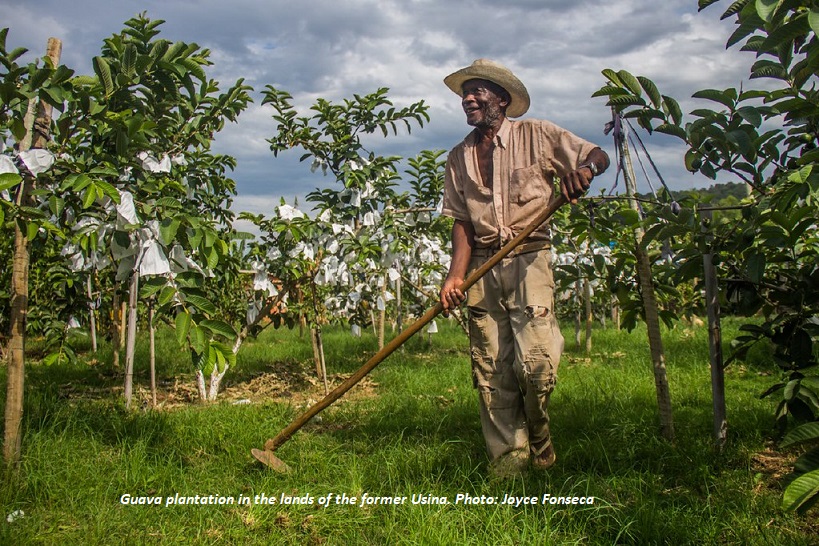 of Campo do Meio, in 1997, in the face of labor conflicts involving the former Ariadnópolis Plant, Companhia Agropecuária Irmãos Azevedo (CAPIA), which have not yet been fully resolved to date , there are still workers who have not received their rights. We organized ourselves through these processes of struggle and resistance that later, in 1999, resulted in the occupation of the unproductive lands of the old Mill after its bankruptcy.
of Campo do Meio, in 1997, in the face of labor conflicts involving the former Ariadnópolis Plant, Companhia Agropecuária Irmãos Azevedo (CAPIA), which have not yet been fully resolved to date , there are still workers who have not received their rights. We organized ourselves through these processes of struggle and resistance that later, in 1999, resulted in the occupation of the unproductive lands of the old Mill after its bankruptcy.
Read about the history and development of Quilombo Campo Grande – the struggle for land rights and how the unproductive land was developed to be productive. In 2017-2018, landless families produced more than 8,500,000 bags of coffee; 55,000 bags of corn and 500 tons of beans. In addition to a diverse horticultural production of vegetables, beans, chickens, cattle and milk. Throughout these years, partnerships have also been established with organizations and institutions in the region that have encouraged production, the promotion of popular education and the improvement of infrastructure for families.
Read the complete story on the struggle and resistance of the men and women of Quilombo Campo Grande.
Trial for the Eviction at Quilombo Campo Grande Encampment (July, 2019).
Justice denies eviction of Quilombo Campo Grande encampment (July 2019)
Eviction of Quilombo Campo Grande and the Eduardo Galeano School
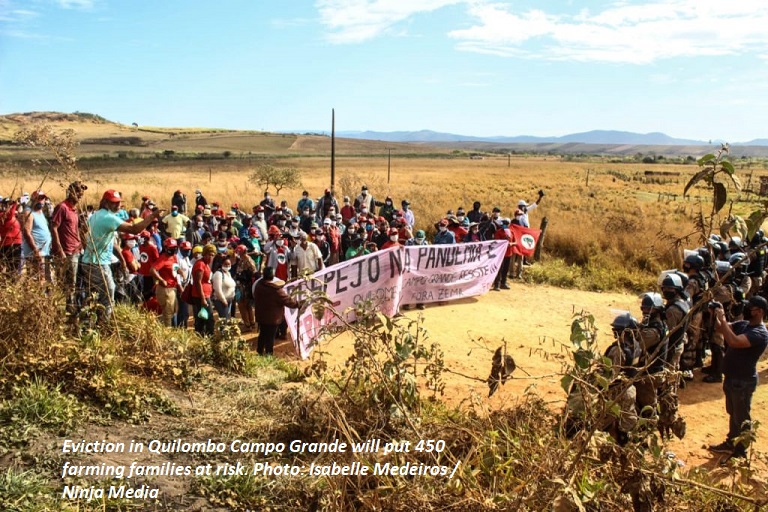 The land repossession of the Quilombo Campo Grande encampment in Minas Gerais was carried out this Friday August 14, after the Military Police committed violent actions against the families that resisted the eviction for almost 60 hours.
The land repossession of the Quilombo Campo Grande encampment in Minas Gerais was carried out this Friday August 14, after the Military Police committed violent actions against the families that resisted the eviction for almost 60 hours.
In the early afternoon, police shot tear gas against the members of the encampment. According to the Landless Rural Workers’ Movement (MST), the houses and crops were destroyed several hours later. The Eduardo Galeano Popular School, where children, youth and adults study, was also destroyed the day before.
The eviction was only completed three days after the process began, because of the 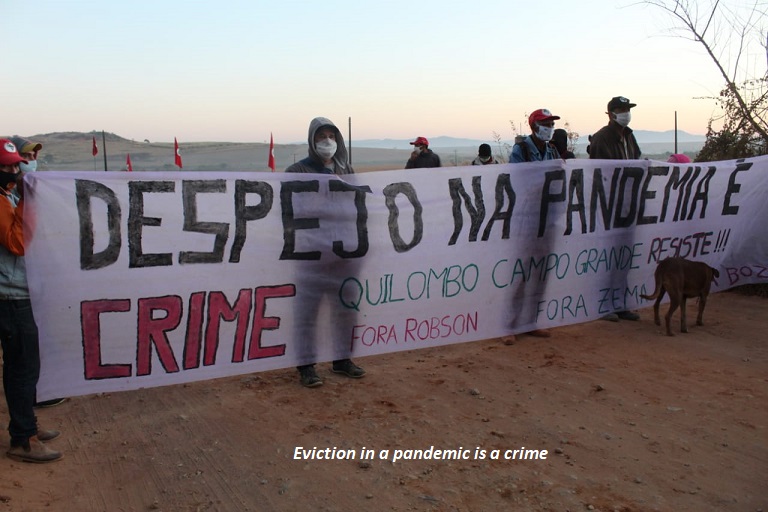 determined resistance of the landless families who have been occupying the area for the last 22 years. Around 450 families lived in the area of the bankrupt sugar mill Ariadnópolis, which closed down activities in 1996. After the occupation and revitalization of the land in 1998, the families had to deal with constant disputes with the owners of the bankrupt company that demanded possession of the territory.
determined resistance of the landless families who have been occupying the area for the last 22 years. Around 450 families lived in the area of the bankrupt sugar mill Ariadnópolis, which closed down activities in 1996. After the occupation and revitalization of the land in 1998, the families had to deal with constant disputes with the owners of the bankrupt company that demanded possession of the territory.
Read the complete story of the eviction of Quilombo Campo Grande - the resistance to the eviction and international outrage over the eviction.
Stop the Eviction of Quilombo Campo Grande! (August 2020)
Police set fire to MST encampment during eviction (August 2020)
Eviction of Landless families in MG is denounced to UN Special Rapporteur (August 2020)
Governor Zema lies on Twitter and police advance on Quilombo Campo Grande (August 2020)
After 60 hours of resistance, MST encampment is violently evicted (August 2020)
THE EDUARDO GALEANO SCHOOL
History of the school
In 1998, the occupation of areas of the former Ariadnópolis Plant takes place, following a conflict that has been going on for more than 20 years. Today we have more than 450 families camped in an area of 4,000 hectares called Quilombo Campo Grande. In 2011, we obtained a settlement area called Nova Conquista, where 300 hectares were expropriated, with 13 families.
During the 24 years that the MST has been in Campo do Meio, the Education Sector has been carrying out youth and adult literacy projects (EJA), and school reinforcement in the 11 encampment areas that form the Quilombo Campo Grande Camp in the municipality.
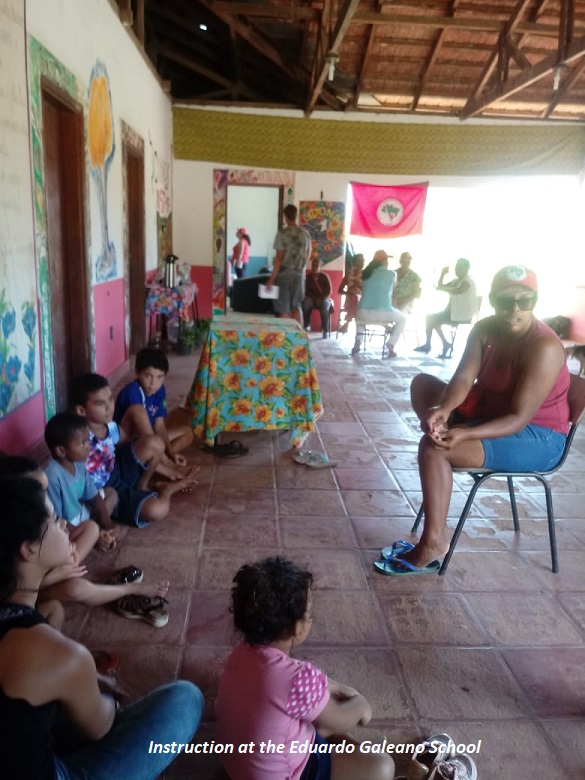 Since 2012, the Education Sector, through a partnership with the Federal Institute of the South in the state of Minas Gerais, formed two groups of technicians in agriculture, who worked in accordance with the Movement's Pedagogy. The courses worked alternately and during the Community Time they are accompanied by the Education Sector that carried out activities in the school space, a building that was abandoned when the Plant went bankrupt. This school had served children of the workers of the failed Plant.
Since 2012, the Education Sector, through a partnership with the Federal Institute of the South in the state of Minas Gerais, formed two groups of technicians in agriculture, who worked in accordance with the Movement's Pedagogy. The courses worked alternately and during the Community Time they are accompanied by the Education Sector that carried out activities in the school space, a building that was abandoned when the Plant went bankrupt. This school had served children of the workers of the failed Plant.
Since 2014, the Education Sector has been strengthened and has been working to formally open the Eduardo Galeano popular school with the objective of serving family farmers in the areas surrounding the camps focusing on the children, settlers and all those encamped to advance Agrarian Reform. The school was completely renovated and rebuilt through community efforts, with donation campaigns, as Dona Ricarda always says “the space had become a corral and we renovated the entire structure, we planted seeds of hope.” In 2016 it was officially opened as a state school, serving teenagers from 11 to 14 years old and adults. We even had four classes in operation, and we managed to form an EJA class with a curriculum aimed at rural schools.
In addition to teaching many adults and the elderly who could write their first words such as  Senhor Zé da Vaca (73 years old) who was one of the families evicted in the crime that happened against the Landless families.
Senhor Zé da Vaca (73 years old) who was one of the families evicted in the crime that happened against the Landless families.
The destruction of the school
The whole process of disputes over land is very complex, there are several maps that include the school area outside the area that should be reinstated. When the current governor of Minas Gerais, Romeu Zema, took over in 2019, classes were suspended according to a meeting held with representatives community with the justification of spending cuts. Budget cuts to technical activities, courses focused on organic production followed, in addition to school support.
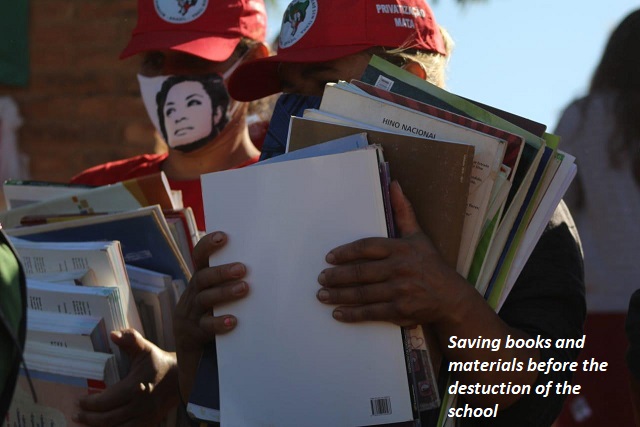 But at the beginning of the year 2020, individuals from the bankrupt company, who lied and claim to live at headquarters, filed a repossession injunction stating that the school area was included in the eviction area, the movement tried to appeal in all possible legal ways, mediating that that space was used by the community and still carried out various activities with children, literacy of young adults, construction of agroforestry systems being a living force for the community, but none of the appeals worked. On the morning of August 12, 2020 the school it was invaded by military police coming from different regions of Minas Gerais and gave one hour to remove everything that was inside the school and started the threats against the children and the workers who were there. In order not to lose books, tables, stoves, refrigerators, the families removed everything that they could. The eviction started, many tears, pain, sadness, added to a huge feeling of indignation. Along with a
But at the beginning of the year 2020, individuals from the bankrupt company, who lied and claim to live at headquarters, filed a repossession injunction stating that the school area was included in the eviction area, the movement tried to appeal in all possible legal ways, mediating that that space was used by the community and still carried out various activities with children, literacy of young adults, construction of agroforestry systems being a living force for the community, but none of the appeals worked. On the morning of August 12, 2020 the school it was invaded by military police coming from different regions of Minas Gerais and gave one hour to remove everything that was inside the school and started the threats against the children and the workers who were there. In order not to lose books, tables, stoves, refrigerators, the families removed everything that they could. The eviction started, many tears, pain, sadness, added to a huge feeling of indignation. Along with a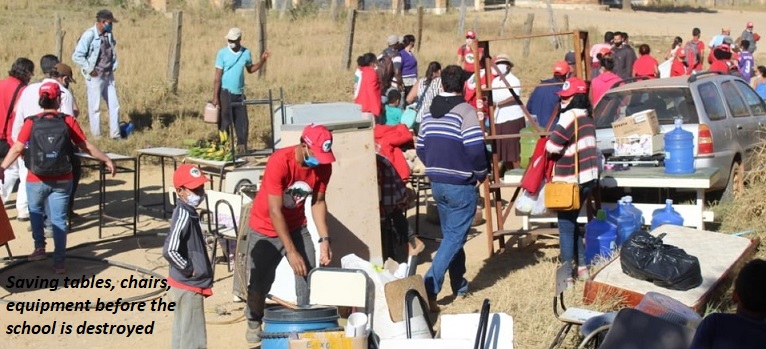 family that lived in the house at the back of the school and contributed to the task of permanently caring for the space, all the families that were there, were immediately impacted due to have a deep affection and love for a space built by the community. After all the people were evacuated, the conflict continued. We did not believe that the physical space would be destroyed, as the structure was also of historical importance for the entire population of Campo do Meio, but as the military police advanced to reintegrate more areas, on August 13, 2020 the school was physically destroyed. The families were prevented by the police from getting close to the place and it was only possible to hear the noise of the machines destroying the structures, only the sound of destruction and violence.
family that lived in the house at the back of the school and contributed to the task of permanently caring for the space, all the families that were there, were immediately impacted due to have a deep affection and love for a space built by the community. After all the people were evacuated, the conflict continued. We did not believe that the physical space would be destroyed, as the structure was also of historical importance for the entire population of Campo do Meio, but as the military police advanced to reintegrate more areas, on August 13, 2020 the school was physically destroyed. The families were prevented by the police from getting close to the place and it was only possible to hear the noise of the machines destroying the structures, only the sound of destruction and violence.
The plans to build a new school
The families of Quilombo Camp Grande have always dreamed of a great school to serve 250 students and educated, from early childhood with ciranda (daycare), going through the early years, up to high school and technical courses focused on agroecological production. Today we no longer have any built-in space; the proposal is to have the school that we need and we will rebuild each destroyed brick. Today the immediate needs are for:
- Building materials in general, sand, stone, wood, tiles, brick. For a school with classrooms, shed, nursery, specific space for children from one to four years old. The format and construction structure will still be defined with the community: a library, toy library, park/playground, sports court, classrooms, fields and areas for technical learning and agro-ecology.
- Equipment in general: agricultural work tools, books, teaching materials, stationery, toys, computers, copying machine, etc.
